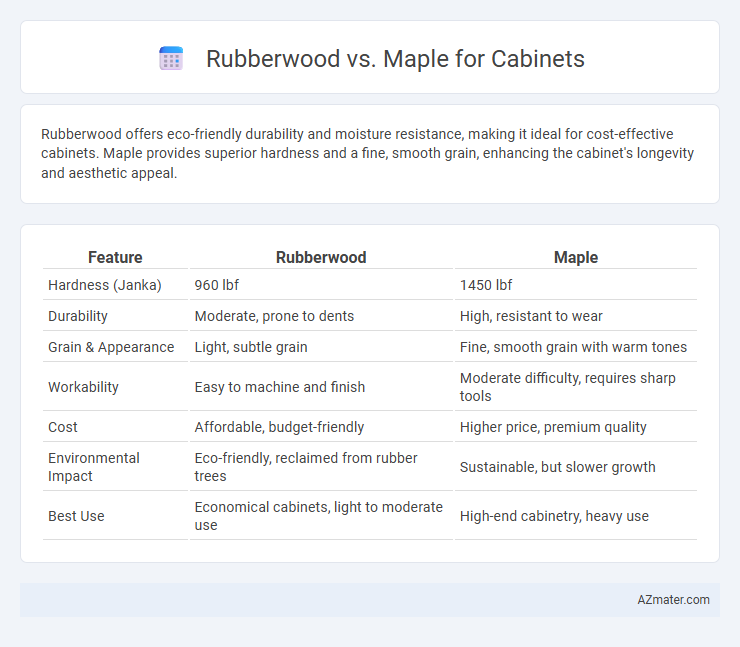Rubberwood offers eco-friendly durability and moisture resistance, making it ideal for cost-effective cabinets. Maple provides superior hardness and a fine, smooth grain, enhancing the cabinet's longevity and aesthetic appeal.
Table of Comparison
| Feature | Rubberwood | Maple |
|---|---|---|
| Hardness (Janka) | 960 lbf | 1450 lbf |
| Durability | Moderate, prone to dents | High, resistant to wear |
| Grain & Appearance | Light, subtle grain | Fine, smooth grain with warm tones |
| Workability | Easy to machine and finish | Moderate difficulty, requires sharp tools |
| Cost | Affordable, budget-friendly | Higher price, premium quality |
| Environmental Impact | Eco-friendly, reclaimed from rubber trees | Sustainable, but slower growth |
| Best Use | Economical cabinets, light to moderate use | High-end cabinetry, heavy use |
Introduction: Rubberwood vs Maple Cabinets
Rubberwood cabinets offer an eco-friendly, cost-effective alternative to traditional hardwoods like maple, prized for its durability and fine grain. Maple cabinets provide superior strength and a smooth finish, ideal for high-traffic kitchen environments requiring long-lasting wear. Choosing between rubberwood and maple depends on balancing budget constraints, environmental considerations, and desired aesthetic appeal.
Origin and Source of Rubberwood and Maple
Rubberwood, primarily sourced from the Para rubber tree (Hevea brasiliensis), originates from Southeast Asia, particularly Thailand, Malaysia, and Indonesia, and is harvested after the latex production declines, making it an eco-friendly byproduct of the rubber industry. Maple, native to North America and parts of Europe, is predominantly obtained from sugar and black maple species, valued for its dense grain and durability in cabinet making. The sustainable sourcing of rubberwood contrasts with the traditional hardwood harvesting of maple, influencing both environmental impact and regional availability.
Appearance and Grain Patterns Compared
Rubberwood exhibits a light, creamy color with a straight, uniform grain pattern, often featuring subtle rays and occasional dark streaks that add character to cabinetry. In contrast, Maple displays a pale, almost white to light reddish-brown hue with a fine, consistent grain and occasional curly or birdseye patterns, giving cabinets a smooth and elegant appearance. The choice between Rubberwood and Maple for cabinets depends on the desired aesthetic, with Rubberwood offering a warmer, natural look and Maple providing a sleek, refined finish.
Hardness and Durability Differences
Rubberwood offers moderate hardness with a Janka rating of approximately 980, making it suitable for cabinets that require resistance to dents and wear in everyday use. Maple, significantly harder with a Janka hardness around 1450, provides superior durability, ideal for high-traffic areas or heavy-use cabinetry. The increased hardness of maple translates to enhanced longevity and better resistance to scratches and dings compared to rubberwood.
Cost Comparison: Rubberwood vs Maple
Rubberwood cabinets typically cost 20-30% less than maple cabinets due to the faster growth cycle and abundant supply of rubberwood trees, making it a cost-effective option for budget-conscious homeowners. Maple wood's higher price reflects its denser grain and superior durability, commonly found in premium cabinetry priced around $200-$250 per linear foot compared to rubberwood's $140-$180 per linear foot. Cost efficiency with rubberwood is enhanced by its eco-friendly sourcing from rubber plantations, while maple's value lies in its longevity and classic appearance despite the higher initial investment.
Workability and Ease of Finishing
Rubberwood offers excellent workability due to its uniform grain and moderate hardness, making it easy to cut, shape, and sand for cabinet projects. Maple is denser and harder, requiring sharper tools and more effort during machining but provides a smooth surface ideal for fine finishes. Both woods accept stains and paints well, though Maple's tight grain yields a more polished, professional finish with less blotching compared to Rubberwood.
Environmental Impact and Sustainability
Rubberwood, sourced from rubber trees after latex harvesting, is highly sustainable due to its role in reusing plantation timber, reducing deforestation and promoting a circular economy. Maple, while durable and popular in cabinetry, often involves slower growth rates and less efficient carbon sequestration, impacting its environmental footprint negatively compared to rubberwood. Choosing rubberwood cabinets supports sustainable forestry practices and lowers ecological impact through resource optimization and waste reduction.
Maintenance and Longevity
Rubberwood cabinets offer moderate durability with resistance to moisture, requiring regular cleaning and occasional sealing to prevent warping, ideal for budget-conscious homeowners seeking eco-friendly options. Maple wood, renowned for its hardness and dense grain, demands less frequent maintenance and provides superior longevity, making it a prime choice for long-term investment in cabinetry. Both woods benefit from avoiding excessive humidity and direct sunlight to maintain structural integrity and aesthetic appeal over time.
Best Applications and Style Preferences
Rubberwood offers a sustainable and cost-effective option ideal for casual, modern, or Scandinavian-style cabinets due to its light color and consistent grain, making it perfect for painted or minimalist finishes. Maple features a harder, dense grain prized for durability and smooth finish, fitting traditional, farmhouse, or contemporary cabinetry that requires a rich, warm tone and fine detailing. Choose Rubberwood for eco-friendly, budget-conscious projects emphasizing sleek, light aesthetics, while Maple suits high-traffic areas demanding robustness and timeless elegance.
Final Verdict: Choosing Between Rubberwood and Maple for Cabinets
Rubberwood offers a sustainable, cost-effective option with a lighter grain and moderate durability, ideal for budget-friendly cabinetry and eco-conscious consumers. Maple provides superior strength, smooth texture, and a classic appearance, making it the preferred choice for high-end, long-lasting cabinets. Choosing between Rubberwood and Maple depends on balancing budget constraints, aesthetic preferences, and durability requirements for your cabinetry project.

Infographic: Rubberwood vs Maple for Cabinet
 azmater.com
azmater.com